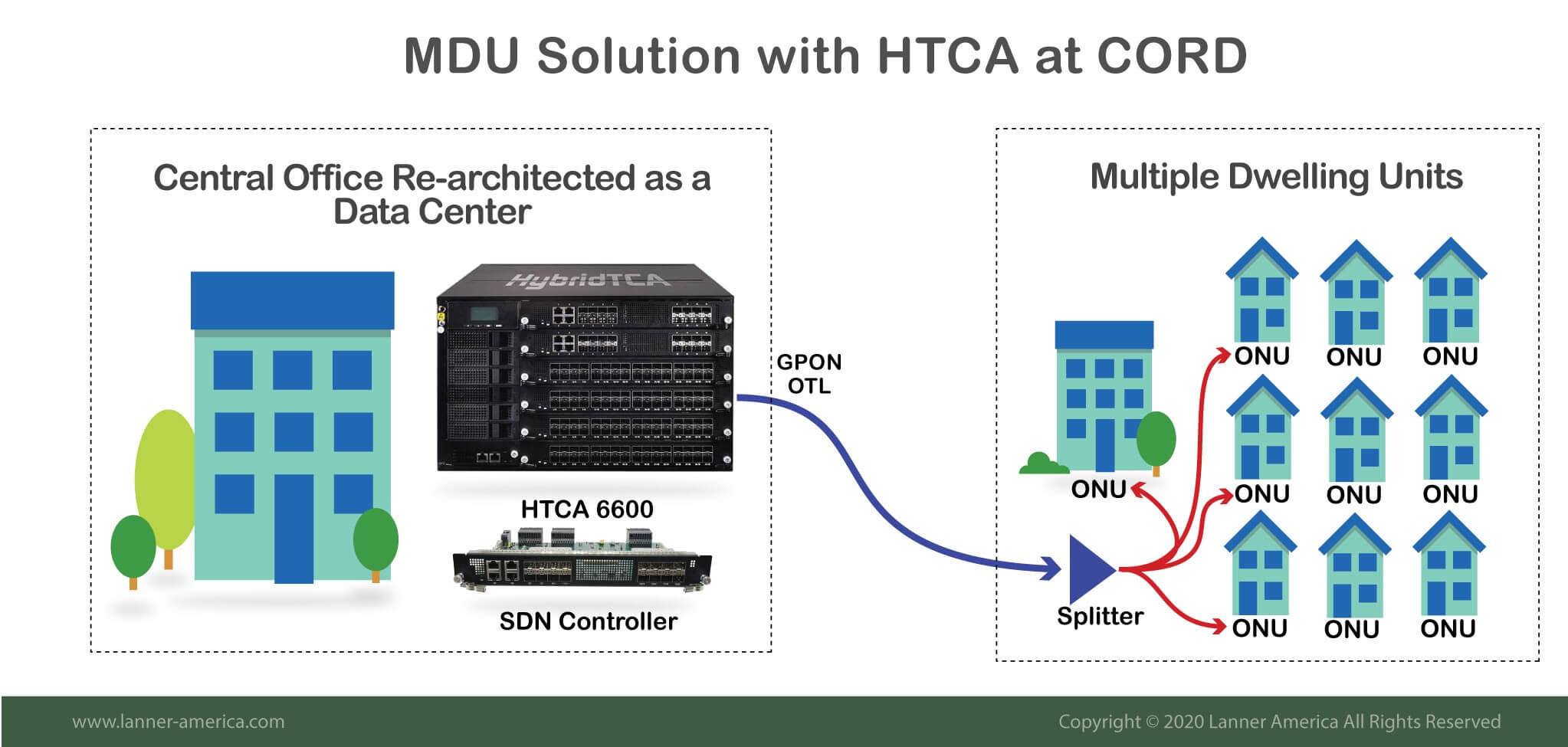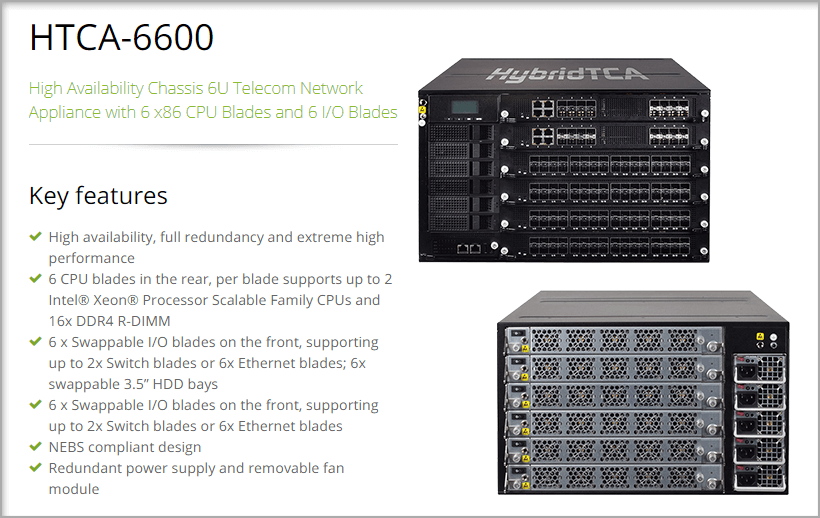
In this solution brief, we will review the challenges that telecom’s Central Offices face when providing seamless services such as broadband internet, voice, and video to subscribers in Multi-Dwelling Units (MDUs).
Then, we will discuss Lanner’s solution to address these challenges. How residential CORD (Central Office Re-architected as a Data Center) can be the right step to innovative Central Offices, and how Lanner’s HTCA-6600 can help provide next-gen hyper-converged infrastructure for CORDs.
Hyperconverged solutions such as HTCA-6600 aim to deliver multi-node compute, massive storage, and high-speed 100G fabric switching in a single appliance.
Challenges
Every day that passes by, network operators see an unparalleled increase in broadband subscriber’s traffic. This increase is clearly due to the quickly evolving technologies such as cloud, IoT, and mobility, which are putting countless challenges on the operators.
Telecom providers struggle to keep up with these changes. They have to be continually replacing legacy purpose-built telecom equipment, adding or removing appliances, and updating systems in their Central Offices (CO), just to keep up with the reality of the market.
Most of the time, the operations at the Central Offices are inefficient, the maintenance/new installations are expensive, and they have a hard time scaling. All these challenges make COs, big operational and capital expenses for operators.
Multiple-Dwelling Units challenge Telecom’s COs
Telecom’s COs are data centers strategically distributed throughout a geographical region, such as a district, or city zone. These COs are where operators connect all of their end-users.
But cities are quickly growing and becoming denser. Most distributed COs have to serve Multi-Dwelling Units (MDUs), which are individual residential units contained within larger housing facilities. Bringing seamless broadband services infrastructure across these special types of residential units can be quite challenging. On top of that, existing MDUs are putting a lot of stress on current COs. Serving fiber to a single-family unit home is different than a multi-story building with hundreds of tenants. MDU’s architecture and space complexity demand different solutions.
All these new challenges such as:
- Changes in user behavior,
- New traffic patterns,
- Bandwidth increase,
- New services,
- High subscriber density.
- Installation space complexity.
Those challenges are pushing Telecom operators to re-think their Central Office (CO)’s architecture. They need agile and efficient architectures.
Dedicated FTTU and Multi-point GPON on a traditional CO?
One of the best ways to ensure bandwidth and seamless triple-play services (data, voice, video) to each unit within an MDU complex, would be to provide a dedicated point-to-point (P2P) optical fiber from the access node located at the central office to the ONT in each unit. Of course, fiber optics through FTTU (Fiber-To-The-Unit) would be the best solution, but the complexities of MDUs buildings demand different solutions. Another solution would be to use the GPON (Gigabit Passive Optical Networks), to distribute access in a point-to-multipoint method, using sets of splitters.
To provide FTTU (Fiber to the Unit), point-to-multipoint access GPON (Gigabit Passive Optical Networks), or even xDSL to the MDUs, the CO needs to evolve.
Solution
Lanner Solution – HybridTCA 6600 Platform (SDN Whitebox) at the CORD
The CORD (Central Office Re-architected as a Data Center) is an innovative approach tailored for service providers. It introduces the economies of scale and aims to improve the service agility of the telco’s CO edge network. CORD is based on Software-Defined Networking (SDN), Network Functions Virtualization (NFV), the Cloud, and MEC (mobile CORD) to build next-generation data centers at the edge.
CORD can provide all the IT infrastructure needs for Multi-Dwelling Units. It makes service delivery more agile and cost-effective, by replacing the proprietary infrastructure of the conventional CO with open-source software running on commodity (off-the-shelf) hardware. It can also provide reliable broadband connectivity, integrate multiple access technologies, and improve security to every single unit within big complexes.
Lanner’s HybridTCA 6600 is a piece of telecom edge infrastructure, specially built for CORD applications. HTCA 6600 enables you to shift compute, storage, and network resources from the core network to the edge. It is also able to provide SDN Switching (with HLM high-performance 10GbE switchblade for HTCA-6000 Series).
HTCA 6600 Features
HTCA 6600 is a highly-available 6U white-box server, fully redundant, and extremely high performance. The server is empowered by Intel Xeon® server-grade CPU blades, each supporting up to two CPUs and 16x DDR4. The appliance also comes with the advanced switching solution BMC StrataXGS, which supports 720 to 1280 Gbps.
The hardware is also NEBS-ready. NEBS is a set of guidelines that define safety, spatial, and environmental design for telecom equipment within a typical Central Office.
This appliance is optimal for installations over FTTx and GPON and is specifically designed for CORD applications, making it the perfect fit for delivering broadband services to MDUs, over ONUs.

Adopting SDN architecture and commoditized hardware pushes CORD to use Intel x86 appliances. Lanner also offers the SDN controller x86 hardware piece in the CORD technology stack (such as HLM 1100A).
The SDN controller provided by Lanner, allows network operators to deploy an SD service layer for advanced active management of different broadband services across MDUs. This controller (using an open protocol) dynamically activates these services and controls subscriber traffic flows through the elements located at the network edge.
Benefits
Hyper-Converged network platforms, such as the HTCA-6600, are the next-generation telecom infrastructure. They aim to provide multi-node compute, high-speed switching (<100G), and massive storage — all in a single network appliance. A hyper-convergence device delivers service agility and economics at scale at the network edge.
Some of the Key Benefits for MDUs:
- Dynamically activate and manage services. NFV and SDN are the two technologies that are the main building blocks of CORD deployment. HTCA 6600 is prevalidated with major SDN and NFV vendors. Along with the SDN controller, the entire solution can include a software-defined layer to allow activation and full management of broadband services across MDUs.
- Reduce OPEX and CAPEX Being able to use open-source frameworks, and commercial off-the-shelf white box provides countless benefits for the telecom carriers. The key benefit for them is clearly reduced costs, as they will be able to reduce hardware, cabling, and consolidate multiple access technologies. CORD also opens opportunities to provide innovative and dynamic services that drive profitability and shape traffic according to applications (video, phone, data) to countless subscribers at MDUs.
- Support for multiple access technology: CORD allows multiple access technologies, such as fiber, copper, wireless, to be consolidated and still provide a single view into the entire system. This consolidation reduces the Total Cost of Ownership (TOC) and reduces the complexities of having multiple proprietary systems. The solution also supports various access technologies such as GPON, FTTx, XDSL, and more.
- Computing at the edge: The HTCA6600 solution allows you to decentralize resources and bring them closer to the edge. CORD enhances applications/services performance and enables low-cost data collection/processing. Computing at the edge, with HTCA 6600, also allows improved analytics and AI processing. MDUs can benefit from the infrastructure built from commodity hardware building blocks, the agility to deploy rapidly, and even elastically scaling services.
Final Words
HTCA 6600 makes service delivery more agile with high-speed programmable SDN switching and brings scaling economics for CORD environments. This device can provide all the IT infrastructure needs for Multiple-Dwelling Units (MDU).
HTCA 6600, along with the SDN controller, provide the optimal solution for the residential broadband demands. It can help deliver broadband network access to end-customers in difficult residential areas such as MDUs through a point-to-multipoint technology GPON, or point to point FTTx.
Converged compute, storage, and network in a single hardware appliance, makes HTCA-6600 the right fit for CORD.
For more information on the solution or HTCA-6600, request a quote.
Image Source: Photo by John Adams on Unsplash
Vector Source: Vecteezy.







